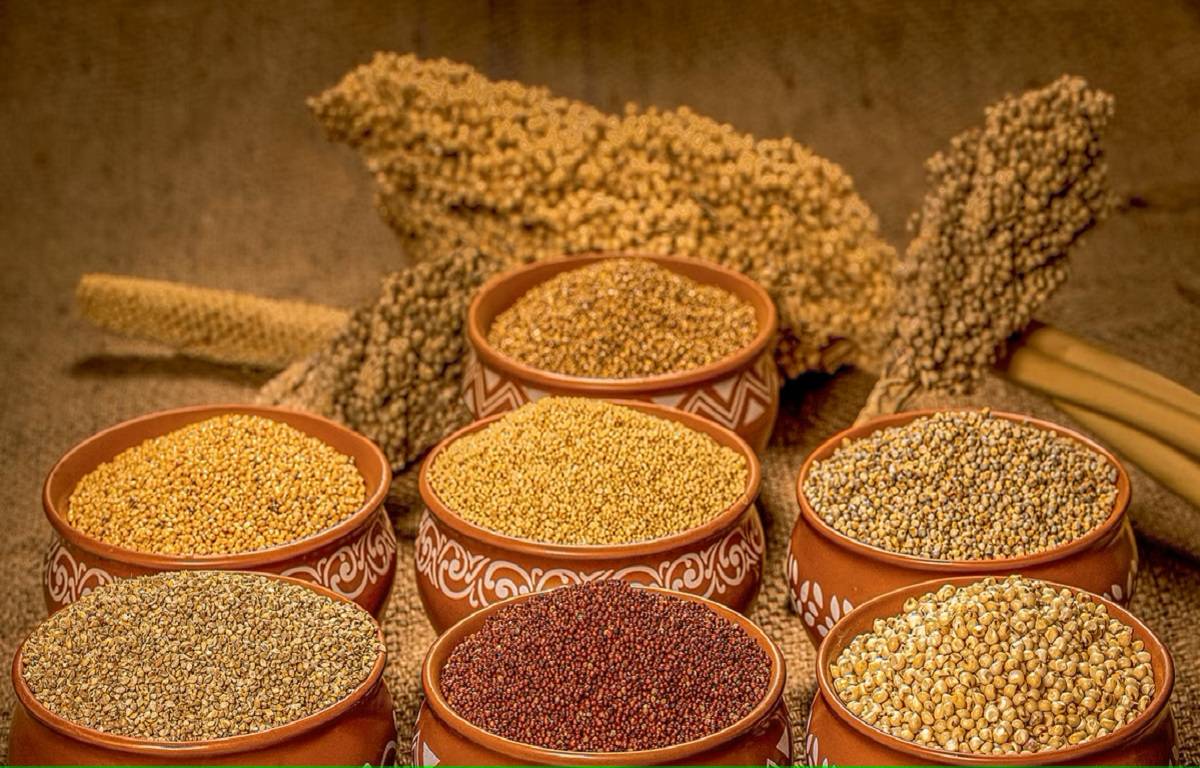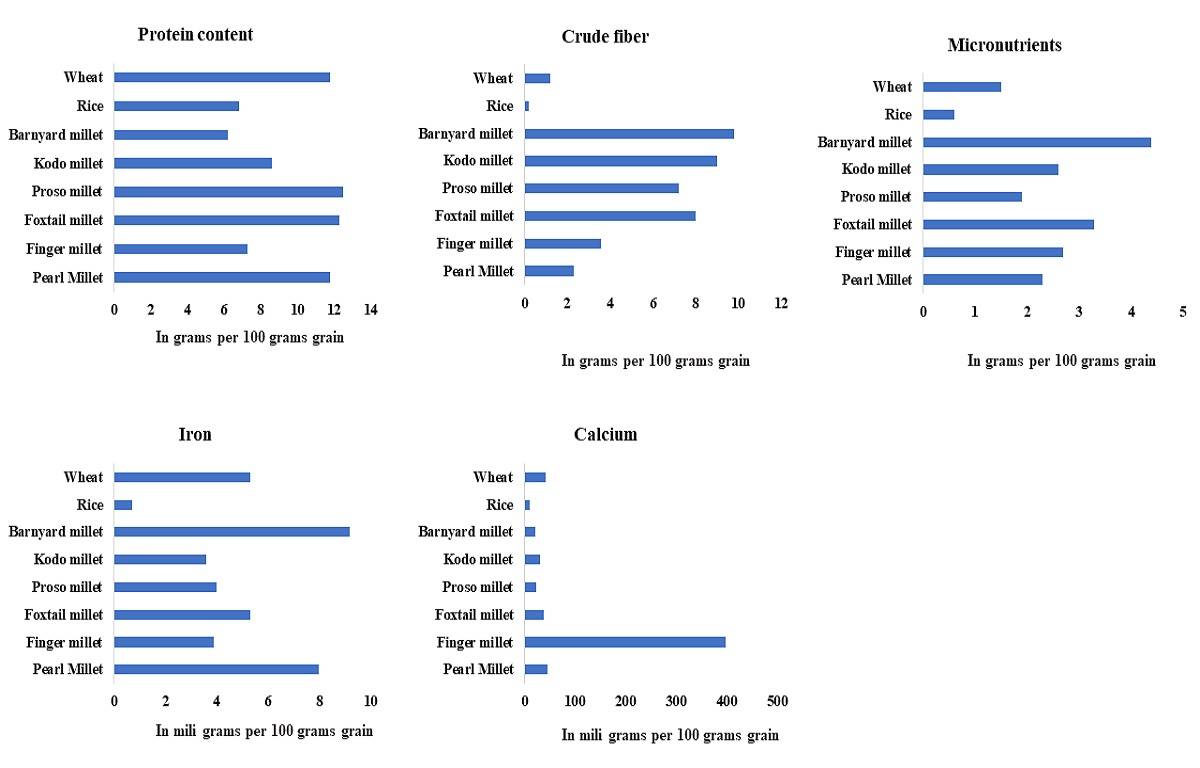
The current global population of 8 billion is expected to reach ~ 10 billion by the end of 2050. At the same time, crop productivity is being continuously challenged by various biotic and abiotic stresses with shrinking agricultural lands. An estimated approximately 720-800 million people were hungry in 2020 and the number is likely to increase in the coming years (FAO 2021). If the situation remains the same, it would be difficult to eradicate global hunger by the end of 2030.
There are around 300,000 to 500,000 plant species on the earth, among which more than 25,000 are speculated to be edible and among that 7,000 have either been cultivated or collected from the wild for human consumption (Singh et al. 2022). However, only 30-40 species are being cultivated for food and among which only 4 species including maize, rice, wheat, and potato account for more than 70% of total plant-derived energy intake. The remaining species remain underutilized despite their immense nutritional potential. Millets are one of the perfect examples of neglected and underutilized crops which once were part of our regular diet, however, currently, it is marginally cultivated and barely consumed among the larger population.
Millets: an introduction
Millet is a general term broadly applied to a group of small-grained cereal crops with excellent climate-resilience and nutritional properties. The most commonly cultivated millet in India is pearl millet (Pennisetum glaucum), finger millet (Elusine coracana), foxtail millet (Setaria italica), Kodo millet (Paspalum scrobiculatum), barnyard millet (Echinochloa colona), little millet (Panicum sumatrense), Broomcorn millet (Panicum miliaceum), and proso millet (Panicum miliaceum), and others.
In contrast to staple cereals (rice, wheat, and maize), millet cultivation does not require well-prepared field conditions, frequent application of chemical fertilizers, regular irrigation, and pest control. Their productivity is not severely affected due to the occurrence of harsh climatic conditions as most of these crops are able to withstand extreme heat and drought conditions (Singh et al. 2021). Millets display improved water- and nitrogen-use efficiencies (WUE and NUE) when compared with other cereal crops.
Nutritional potentials of millets:
Nutritionally, most of the millets are superior or at least equivalent to major cereal grains including rice and wheat. The millet’s grain content especially in terms of carbohydrate, protein, fibers, vitamins, and mineral elements like iron, zinc, phosphorus, potassium, and calcium are 2-3 times higher than the major cereals (Figure 1). Millet flours are gluten-free with a low glycemic index and bioactive compounds of various kinds (Dhaka et al. 2021).
Additionally, millet proteins are reasonably rich in several essential amino acids and sulfur-containing amino acids, including methionine and cysteine (Singh et al. 2012). Both structural and non-structural forms of carbohydrates exist in cereal grains. Cellulose and hemicellulose constitute the structural polysaccharide while starch and free sugars represent the non-structural carbohydrate. Starch is the major source of carbohydrates we consume from cereal grains.

Its proportion varies from 55-75% in millets (Saleh et al. 2013). Starch is composed of amylose, a linear polyglucan linked through α-1,4 linkages, and amylopectin, a branched polyglucan chain linked through α-1,6 bonds at the branching points. Amylose and amylopectin are arranged in a specialized order to attain the spherical granular structures of starch in the endosperm. The proportion of amylose varies from 20-30%, whereas 70-80% of the starch is formed of branched amylopectin.
The higher amount of resistant starch in millet is valuable for maintaining low glucose levels after carbohydrate consumption. Small millets are also a good source of essential fatty acids including linolenic acid, linoleic acid, and arachidonic acid. In comparison to staple cereals millets are also a rich source of many B vitamins and beta-carotene. While millets are known for their superior nutritional merits, they also have some antinutritive compounds like phytic acid, polyphenols, and tannis. Further, the rapid rancidity of some of the millet’s flours renders a bitter taste to the derived food thereby acting as a major factor affecting the larger acceptability of the crop (Bandhyopadhyay et al. 2022). It is the foremost challenge to eliminate the bioavailability of these compounds to re-establish millet’s popularity among the general people.
Therapeutic values of millet consumption
Unlike most conventional cereal grains (wheat, maize, and rice), millet-based foods have high therapeutic values. Low glycemic indices of millet flour offer an ideal food choice for people with type II diabetes. Blood glucose levels and serum lipid profiling has been significantly reduced in diabetes mellitus-affected rats when provided with pearl millet-supplemented diets (Sada et al. 2016). Further epidemiological evidence also indicates that millet-consuming populations have a lower incidence of diabetes (Kim et al. 2011). Polysaccharides like xylose and arabinose from finger millet can act as active prebiotics and have wound-healing potential (Rajasekaran et al. 2004). Phenolic compounds from millets have anti-inflammatory, anti-mutagenic, anti-oestrogenic, antioxidant, and antibacterial effects (Devi et al. 2014).
The bound polyphenol compounds from millets have exhibited an anti-cancerous effect on human HCT-116 cells through caspase-regulated apoptosis (Shi et al. 2015). Polyphenols in millets are rich in caffeic acid, gallic acid, p-coumaric acid, ferulic acid, chlorogenic acid, syringic acid, catechol, and carotenoid (Dhaka et al. 2021). These compounds act as excellent antioxidants and reduce oxidative damage (Sharma et al. 2016). Thus, millets are a natural storehouse of various antioxidants and nutraceutical food ingredients.
Challenges in mainstreaming millet cultivation and the way forward
Although millet domestication starts earlier than our major cereal crops, the green revolution and all other crop improvement programs primarily focused on rice and wheat. This caused their marginal cultivation and disappearance of millet-based foods from the food basket of a larger proportion of the human population. Mainstreaming millet cultivation can impact the livelihood of farmers with limited resources. They must be grown together with staple crops to enhance the diversification of the existing cropping system. That might provide agricultural security during the sudden occurrence of adverse climatic conditions as most of the millet crops can withstand such circumstances with minimal loss (Singh et al. 2022).
Under the present scenario, millet production is inconsistent due to several factors. The lack of improved varieties and modern crop management systems are some of the reasons behind their marginal cultivation. Extensive research investment and proper policies are required to reintroduce their cropping and consumption parallel to the major cereals. Modern breeding techniques, genetic engineering, and genome editing technologies should be employed to these crops for targeted trait improvement. Biofortification of nutritional traits in millet can directly impact the health of consuming populations that are largely underprivileged. Popularizing millet consumption may swift the goal of achieving zero hunger by the year 2030.
Reference
Bandyopadhyay T, Singh RK, Ramesh P, Maurya J, Prasad M (2022) The Promise of Millets in the Twenty-First Century: Emphasis on Breeding, Nutrition, Food Security and Sustainability. J Soil Sci Plant Nutr https://doi.org/10.1007/s42729-022-01070-w.
Devi PB, Vijayabharathi R, Sathyabama S, Malleshi NG, Priyadarisini VB (2014) Health benefits of finger millet (Eleusine coracana L.) polyphenols and dietary fiber: a review. J Food Sci Technol 51:1021–1040.
Dhaka A, Singh RK, Muthamilarasan M, Prasad M (2021) Genetics and Genomics Interventions for Promoting Millets as Functional Foods. Curr Genomics 22:154-163. doi: 10.2174/1389202922666210225084212
FAO (2021) The state of food security and nutrition in the world 2021: the world is at a critical juncture. FAO, Rome
Kim JS, Hyun TK, Kim MJ (2011) The inhibitory effects of ethanol extracts from sorghum, foxtail millet and proso millet on α-glucosidase and α-amylase activities. Food Chem 124:1647–1651.
Rajasekaran NS, Nithya M, Rose C, Chandra TS (2016) The effect of finger millet feeding on the early responses during the process of wound healing in diabetic rats. Biochim Biophys Acta 1689:190-201.
Sada NH, Tanko Y, Gidado NM, Mohammed A (2016) Antidiabetic effect of fermented pennisetum glaucum (Millet) supplement in alloxan induced hyperglycemic wistar rats. Bayero J Pure Appl Sci, 9:138-141.
Saleh ASM, Zhang Q, Chen J, Shen Q (2013) Millet grains: nutritional quality, processing, and potential health benefits. Compr Rev Food Sci Food Saf 12:281-295.
Sharma S, Saxena DC, Riar CS (2016) Nutritional, sensory and in-vitro antioxidant characteristics of gluten free cookies prepared from flour blends of minor millets. J Cereal Sci 72:153-161.
Singh RK, Muthamilarasan M, Prasad M (2021) Biotechnological approaches to dissect climate-resilient traits in millets and their application in crop improvement. J Biotechnol 327:64-73.
Singh RK, Sreenivasulu N, Prasad M (2022) Potential of underutilized crops to introduce nutritional diversity and achieve zero hunger. Funct Integr Genomics 22:1459-1465.
About the Author:
Roshan Kumar Singh1, Manoj Prasad1,2*
1National Institute of Plant Genome Research, Aruna Asaf Ali Marg, New Delhi, India
2Department of Plant Sciences, University of Hyderabad, Hyderabad 500046, India
*Corresponding author
Manoj Prasad
National Institute of Plant Genome Research
Aruna Asaf Ali Marg, New Delhi 110067, India
Tel: 91-11-26741612, Fax: 91-11-26741658
E-mail: manoj_prasad@nipgr.ac.in
ORCiD: 0000-0003-0691-0163











Share your comments